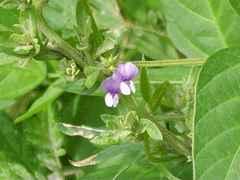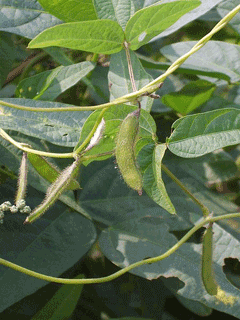 |
|
http://commons.wikimedia.org/wiki/User:Dalgial |
 |
| http://commons.wikimedia.org/wiki/User:Dalgial |
Translate this page:
Summary
UPDATE 24/4/2012: Glycine soja Siebold & Zucc. is a synonym of Glycine max subsp. soja (Siebold & Zucc.) H.Ohashi
Physical Characteristics

 Glycine soja is a ANNUAL growing to 0.6 m (2ft).
Glycine soja is a ANNUAL growing to 0.6 m (2ft).
See above for USDA hardiness. It is hardy to UK zone 8 and is frost tender. It is in flower from July to September. The species is hermaphrodite (has both male and female organs) and is pollinated by Insects.
It can fix Nitrogen.
Suitable for: light (sandy) and medium (loamy) soils and prefers well-drained soil. Suitable pH: mildly acid, neutral and basic (mildly alkaline) soils. It cannot grow in the shade. It prefers moist soil.
UK Hardiness Map
US Hardiness Map
Synonyms
Glycine formosa Hosok. Glycine javanica Thunb. Glycine ussuriensis Regel & Maack
Plant Habitats
Cultivated Beds;
Edible Uses
Edible Parts: Leaves Oil Oil Seed Seedpod
Edible Uses: Coffee Milk Oil Oil
Mature seed - cooked[2, 33]. Very rich in protein, the seeds can be eaten as they are in soups, stews etc[183], though they are very commonly used in the preparation of various meat substitutes[34, 46]. The dried seed can be ground into a flour and added to cereal flours or used for making noodles etc[183]. The Japanese make a powder from the roasted and ground seed, it is called 'Kinako' and has a nutty flavour and fragrance - it is used in many popular confections[183]. The sprouted seed is eaten raw or added to cooked dishes. The toasted seeds can be eaten as a peanut-like snack[183]. The seed is also made into numerous fermented foods such as miso and tempeh[183] and is also used to make soya milk, used in place of cow's milk. The seed contains 20% oil and 30 - 45% protein[100]. The immature seed is cooked and used like peas or eaten raw in salads[105, 183]. The strongly roasted and ground seeds are used as a coffee substitute[183]. The young seedpods are cooked and used like French beans[116, 183]. An edible oil is obtained from the seed. It is cooked or used as a dressing in salads etc[34, 183]. Young leaves - raw or cooked[179, 183].
References More on Edible Uses
Medicinal Uses
Plants For A Future can not take any responsibility for any adverse effects from the use of plants. Always seek advice from a professional before using a plant medicinally.
Antidote Astringent Diaphoretic Laxative Ophthalmic Resolvent Stomachic
The fermented seed is weakly diaphoretic and stomachic[176]. It is used in the treatment of colds, fevers and headaches, insomnia, irritability and a stuffy sensation in the chest[176]. The bruised leaves are applied to snakebite[218]. The flowers are used in the treatment of blindness and opacity of the cornea[218]. The ashes of the stems are applied to granular haemorrhoids or fungus growths on the anus[218]. The immature seedpods are chewed to a pulp and applied to corneal and smallpox ulcers[218]. The seed is antidote[218]. It is considered to be specific for the healthy functioning of bowels, heart, kidney, liver and stomach[218]. The seed sprouts are constructive, laxative and resolvent[218]. They are used in the treatment of oedema, dysuria, chest fullness, decreased perspiration, the initial stages of flu and arthralgia[176]. A decoction of the bark is astringent[240]. The German Commission E Monographs, a therapeutic guide to herbal medicine, approve Glycine soja Wild Soya Bean for raised blood levels & cholesterol (see [302] for critics of commission E).
References More on Medicinal Uses
The Bookshop: Edible Plant Books
Our Latest books on Perennial Plants For Food Forests and Permaculture Gardens in paperback or digital formats.

Edible Tropical Plants
Food Forest Plants for Hotter Conditions: 250+ Plants For Tropical Food Forests & Permaculture Gardens.
More

Edible Temperate Plants
Plants for Your Food Forest: 500 Plants for Temperate Food Forests & Permaculture Gardens.
More

More Books
PFAF have eight books available in paperback and digital formats. Browse the shop for more information.
Shop Now
Other Uses
Oil Oil
The seed contains up to 20% of an edible semi-drying oil[171]. It is non-drying according to another report[57]. This oil has a very wide range of applications and is commonly used in the chemical industry[171, 206]. It is used in making soap, plastics, paints etc[34, 46, 100].
Special Uses
Nitrogen Fixer
References More on Other Uses
Cultivation details
Requires a rich soil and a sunny position[33, 38]. Prefers a well-drained sandy soil[1]. Prefers a slightly acid soil[200, 206]. Does not grow well in a wet climate[132]. This is the wild ancestor of the cultivated soya bean and is of potential value as a genetic resource, especially when trying to breed for increased yields. This species has a symbiotic relationship with certain soil bacteria, these bacteria form nodules on the roots and fix atmospheric nitrogen. Some of this nitrogen is utilized by the growing plant but some can also be used by other plants growing nearby[200]. Seed can be purchased that has been treated with this rhizobium, it is unnecessary on soils with a pH below 5.5 but can be helpful on other soils[206]. When removing plant remains at the end of the growing season, it is best to only remove the aerial parts of the plant, leaving the roots in the ground to decay and release their nitrogen.
References Carbon Farming Information and Carbon Sequestration Information
Temperature Converter
Type a value in the Celsius field to convert the value to Fahrenheit:
Fahrenheit:
The PFAF Bookshop
Plants For A Future have a number of books available in paperback and digital form. Book titles include Edible Plants, Edible Perennials, Edible Trees,Edible Shrubs, Woodland Gardening, and Temperate Food Forest Plants. Our new book is Food Forest Plants For Hotter Conditions (Tropical and Sub-Tropical).
Shop Now
Plant Propagation
Pre-soak the seed for 12 hours in warm water and then sow in early spring in a greenhouse. The seed should germinate within two weeks at a temperature between 12 - 16°c[206]. When they are large enough to handle, prick the seedlings out into individual pots and plant them out in late spring or early summer, after the last expected frosts. Seed can also be pre-soaked for 12 hours in warm water and then sown in situ in late spring, though this will not yield well unless the summer is very hot.
Other Names
If available other names are mentioned here
Native Range
TEMPERATE ASIA: Russian Federation (Primorye, Amur), China (north & central), Korea, Japan, Taiwan (north)
Weed Potential
Right plant wrong place. We are currently updating this section.
Please note that a plant may be invasive in one area but may not in your area so it's worth checking.
Conservation Status
IUCN Red List of Threatened Plants Status :

Growth: S = slow M = medium F = fast. Soil: L = light (sandy) M = medium H = heavy (clay). pH: A = acid N = neutral B = basic (alkaline). Shade: F = full shade S = semi-shade N = no shade. Moisture: D = dry M = Moist We = wet Wa = water.
Now available:
Food Forest Plants for Mediterranean Conditions
350+ Perennial Plants For Mediterranean and Drier Food Forests and Permaculture Gardens.
[Paperback and eBook]
This is the third in Plants For A Future's series of plant guides for food forests tailored to
specific climate zones. Following volumes on temperate and tropical ecosystems, this book focuses
on species suited to Mediterranean conditions—regions with hot, dry summers and cool, wet winters,
often facing the added challenge of climate change.
Read More
Expert comment
Author
Siebold.&Zucc.
Botanical References
58
Links / References
For a list of references used on this page please go here
Readers comment
| Add a comment |
|
If you have important information about this plant that may help other users please add a comment or link below. Only comments or links that are felt to be directly relevant to a plant will be included. If you think a comment/link or information contained on this page is inaccurate or misleading we would welcome your feedback at [email protected]. If you have questions about a plant please use the Forum on this website as we do not have the resources to answer questions ourselves.
* Please note: the comments by website users are not necessarily those held by PFAF and may give misleading or inaccurate information.
To leave a comment please Register or login here All comments need to be approved so will not appear immediately.
|
|